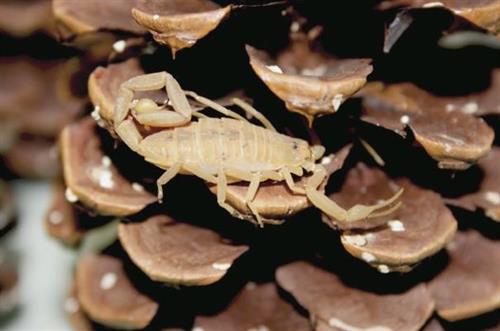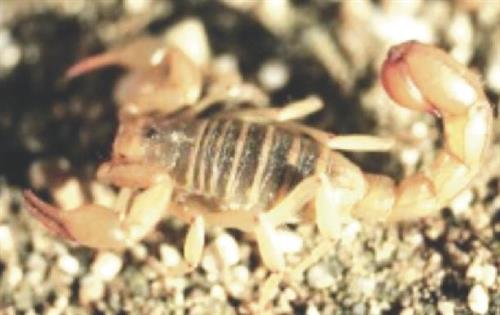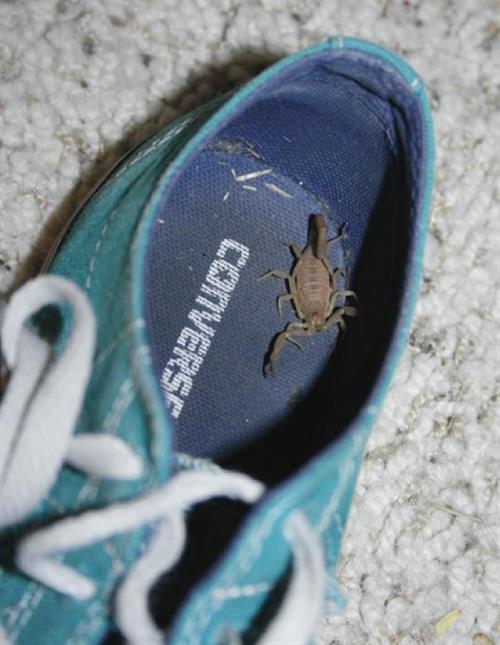Authored by Dawn H. Gouge, Shujuan (Lucy) Li, Christopher Bibbs,
and Shaku Nair, University of Arizona.
There are close to 2,000 described species of scorpions worldwide, at least 100 in the U.S., and more than 50 species in the desert southwestern states. Scorpions have long been of concern and interest to humans primarily due to their ability to give painful, and sometimes life threatening stings, but also because they are important and beneficial components of many ecosystems.
The most commonly occurring scorpion species in the low desert southwest include:
 Arizona bark scorpion Centruroides sculpturatus (Fig. 1). This species also colonizes small parts of California, Nevada, New Mexico, Utah, Colorado, Texas, and northwestern Mexico. Adults are 2-3 inches in length, have
relatively slender appendages and a long, slender tail. Their coloration and markings are highly variable, some being pale in color, others darker with stripes or checkered patterning. The Arizona bark scorpion is the only scorpion of medical
concern in the U.S. (Curry et al. 1983), and while all native scorpions can sting, only Arizona bark scorpion stings are hazardous to human health.
Arizona bark scorpion Centruroides sculpturatus (Fig. 1). This species also colonizes small parts of California, Nevada, New Mexico, Utah, Colorado, Texas, and northwestern Mexico. Adults are 2-3 inches in length, have
relatively slender appendages and a long, slender tail. Their coloration and markings are highly variable, some being pale in color, others darker with stripes or checkered patterning. The Arizona bark scorpion is the only scorpion of medical
concern in the U.S. (Curry et al. 1983), and while all native scorpions can sting, only Arizona bark scorpion stings are hazardous to human health.
 Arizona giant hairy scorpion Hadrurus arizonensis (Fig. 2) is the largest scorpion in the U.S.; they are heavy bodied scorpions, and adults often exceed 5 inches in length. This species can be found in the
Sonoran and Mojave Desert areas of Arizona, California, Nevada andUtah, as well as the Sonoran and Baja California Norte areas of Mexico. They have a mild venom, but strong pedipalps that they use to grasp prey. The scorpions often have a darker
body, pale sides, and pale buff colored appendages, when viewed from above. They feed on a wide variety of insects, arachnids, small lizards and other animals. This species is also called the desert hairy scorpion as they are found in low sandy
areas.
Arizona giant hairy scorpion Hadrurus arizonensis (Fig. 2) is the largest scorpion in the U.S.; they are heavy bodied scorpions, and adults often exceed 5 inches in length. This species can be found in the
Sonoran and Mojave Desert areas of Arizona, California, Nevada andUtah, as well as the Sonoran and Baja California Norte areas of Mexico. They have a mild venom, but strong pedipalps that they use to grasp prey. The scorpions often have a darker
body, pale sides, and pale buff colored appendages, when viewed from above. They feed on a wide variety of insects, arachnids, small lizards and other animals. This species is also called the desert hairy scorpion as they are found in low sandy
areas.
These harmless giants spend most of their time under rocks and in shallow burrows; they are a beneficial addition to your home landscape as they consume Arizona bark scorpions voraciously.
The Arizona stripe-tailed scorpion Paravaejovis spinigerus, and the yellow ground scorpion Vaejovis confusus (Fig. 3), are burrowing species, and full-grown at less than 3 inches in length. They are often mistaken for bark scorpions, but the stripe-tailed

Figure 3. Arizona stripe-tailed scorpion (left), and yellow ground scorpion (right)
(both about 1 inch in length). Black arrows show the pedipalps.
scorpion is heavily armored, with comparatively bulkier pedipalps (Fig. 3, left) and tail. Although yellow ground scorpions have more delicate pedipalps (Fig. 3, right), their tails are wider and much bulkier. Both scorpions feed on smaller arthropods, and seek moisture.
The Arizona stripe-tailed scorpion is found in Arizona, California, southwestern New Mexico and northwestern Sonora in Mexico, while the less commonly found, but broadly present yellow ground scorpion is reported throughout much of Arizona, California, Idaho, Nevada, Utah and northern Mexico.
Both scorpions are typically found on sandy soils in a variety of habitats, from desert floor to rocky hillsides, and under many surface objects (including sleeping bags, shoes, etc.) where they dig short burrows or “scrapes” for protection. The scorpions sting, but their venom is relatively mild, and does not usually require medical intervention.
 In the desert southwest, we share our space with the medically important Arizona bark scorpion, and our homes provide these amazing and adaptable scorpions with plentiful food, water, and shelter. To eliminate scorpions from our landscapes would
require extremely unhealthy and illegal chemical use that would at best, be a temporary eradication of the pest. A far healthier and sustainable approach is to accept that scorpions are part of the natural landscape, and take precautions to exclude
the creatures from the interior of homes and buildings. The following are useful tips for the safe and harmonious sharing of our incredible desert landscape.
In the desert southwest, we share our space with the medically important Arizona bark scorpion, and our homes provide these amazing and adaptable scorpions with plentiful food, water, and shelter. To eliminate scorpions from our landscapes would
require extremely unhealthy and illegal chemical use that would at best, be a temporary eradication of the pest. A far healthier and sustainable approach is to accept that scorpions are part of the natural landscape, and take precautions to exclude
the creatures from the interior of homes and buildings. The following are useful tips for the safe and harmonious sharing of our incredible desert landscape.
▪ Educate children not to touch scorpions and report scorpion sightings to an adult caregiver. ▪ Be vigilant while walking outdoors at night; wear shoes. Be vigilant indoors at night; wear slippers or flip-flops.
▪ Do not store shoes on the floor, especially outdoors (Fig. 4).
▪ Pest-proof your home on the exterior and interior (see Https://extension.arizona.edu/sites/extension. arizona.edu/files/pubs/az16772015.pdf).
▪ Do not allow towels or clothing to be discarded on the ground indoors or outdoors.
▪ Be careful when camping or during other outdoor activities to ensure that a scorpion has not made a home in your clothes, shoes or sleeping bags.
▪ If you bring firewood in from outdoor storage areas, place it directly on the fire; do not store woodpiles inside the home.
▪ Do not allow wood, rocks, clutter or debris to build up against the home.
▪ Scorpions glow brightly under Ultraviolet light (UV or black light), use a UV light to inspect inside your home for scorpions before bedtime
(Fig. 5).
▪ Conduct UV light collections several times during summer months between 8-11pm. Make sure that you wear boots and have long tongs if you want to capture the scorpions to move them. As they are beneficial to our environment please consider collecting and releasing the scorpions into the natural desert rather than killing them.
▪ Keep grass closely mowed near the home. Prune bushes and overhanging tree branches away from the structure. Tree branches can provide a path to the roof for scorpions. Minimize low growing ground cover vegetation.
▪ Store garbage containers in a frame that allows them to rest above ground level.
▪ Install weather-stripping around doors and windows and ensure a snug fit.
▪ Ensure door sweeps are tight fitting with no gaps.
▪ Screen weep holes in brick veneer or weep screed with coarse steel mesh (the holes should not be plugged or sealed as they are important for the ventilation of wall spaces).
▪ Caulk around roof eaves, pipes and any other points and wall penetrations into the building.
▪ Keep window screens in good repair. Make sure they fit tightly in the window frame.
▪ Stucco and cap hollow-block walls to make them less inviting harborage zones.
▪ Keep your tetanus shots and vaccinations up-to-date.
Scorpions are extremely difficult to eradicate. If you regularly find scorpions inside your home, call a pest management professional experienced in the management of scorpions. Eliminating their food sources (crickets and other insects) can help, but will not eliminate scorpions from around the home. If a reduced scorpion population is desirable, additional steps can be taken. However, scorpions are difficult to manage with pesticides alone. Pest-proofing your home or structure is by far the most effective way to reduce scorpion contact and potential scorpion stings.
If you would like to know more, please read “Scorpions of the Desert Southwest United States” https://extension.arizona.edu/sites/extension.arizona.edu/files/pubs/az1768 2018.pdf